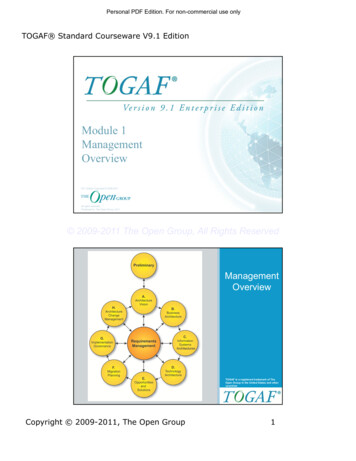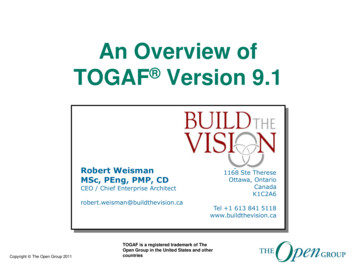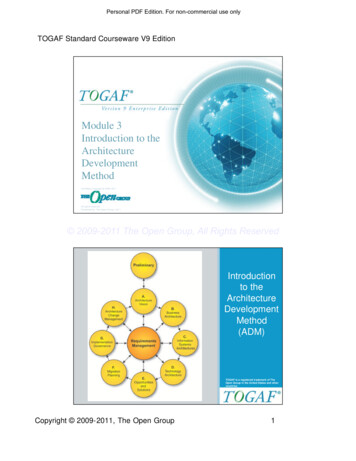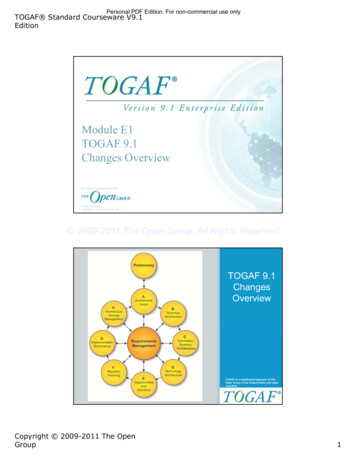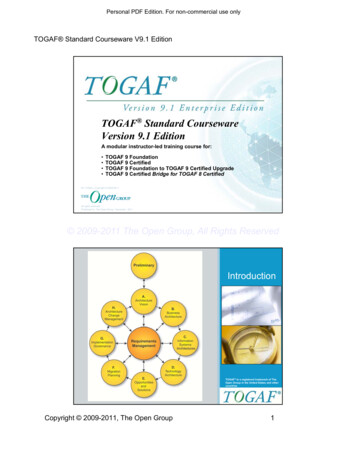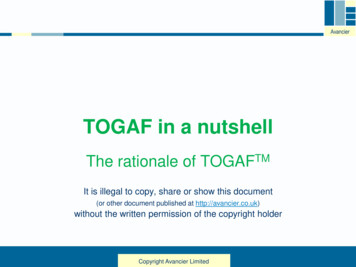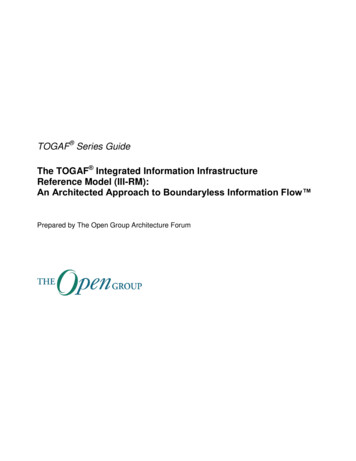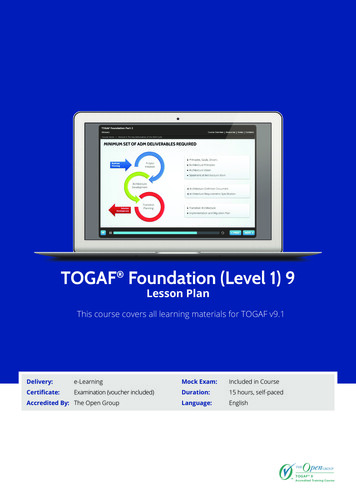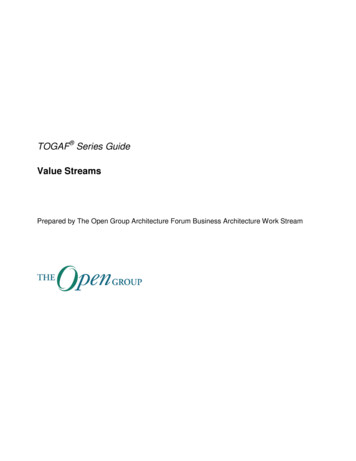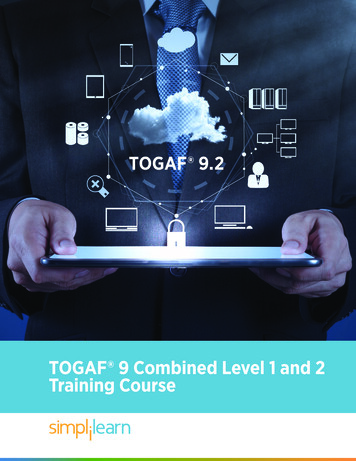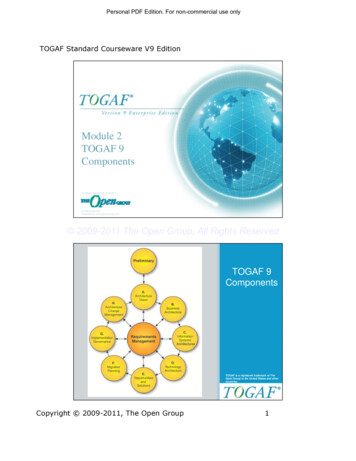
Transcription
Personal PDF Edition. For non-commercial use onlyTOGAF Standard Courseware V9 EditionModule 2TOGAF 9ComponentsV9 Edition Copyright 2010-2011Slide 1 of 27All rights reservedPublished by The Open Group, 2011 2009-2011 The Open Group, All Rights ReservedTOGAF 9ComponentsTOGAF is a registered trademark of TheOpen Group in the United States and othercountriesSlide 2 of 27Copyright 2009-2011, The Open Group1
Personal PDF Edition. For non-commercial use onlyTOGAF Standard Courseware V9 EditionModule Objectives To highlight and introduce the main components and keyconcepts of TOGAF 9 The Architecture Development Method (ADM)ADM Guidelines and TechniquesArchitecture Content Framework The Enterprise Continuum TOGAF Reference ModelsThe Architecture Capability Framework– Deliverables, artifacts, building blocks– The Architecture Repository– Establishing an EA Capability– To understand the TOGAF Document Categorization modelSlide 3 of 27 2009-2011 The Open Group, All Rights ReservedTOGAF 9 ComponentsADMADM Guidelines& TechniquesArchitecture ContentFrameworkEnterprise ContinuumReference ModelsArchitecture CapabilityFrameworkSlide 4 of 27Copyright 2009-2011, The Open Group2
Personal PDF Edition. For non-commercial use onlyTOGAF Standard Courseware V9 EditionPart I - IntroductionPreface, Executive Overview, Core Concepts, Definitions andRelease NotesPart II – Architecture Development MethodIntroduction to ADMADM Phase NarrativesPart III – ADM Guidelines and TechniquesGuidelines for Adapting the ADM ProcessTechniques for Architecture DevelopmentPart IV – Architecture Content FrameworkContent MetamodelArchitectural ArtifactsArchitecture DeliverablesBuilding BlocksPart V – Enterprise Continuum and ToolsEnterprise ContinuumArchitecture PartitioningArchitecture RepositoryTools for Architecture DevelopmentPart VI – TOGAF Reference ModelsFoundation Architecture: Technical Reference ModelIntegrated Information Infrastructure Reference ModelPart VII – Architecture Capability FrameworkArchitecture BoardArchitecture ComplianceArchitecture ContractsArchitecture GovernanceArchitecture Maturity ModelsArchitecture Skills FrameworkSlide 5 of 27 2009-2011 The Open Group, All Rights ReservedThe ArchitectureDevelopment Method The core of TOGAF A proven way of developingan architectureSpecifically designed toaddress businessrequirementsAn iterative methodA set of architecture views toensure that a complex set ofrequirements are adequatelyaddressed Slide 6 of 27Copyright 2009-2011, The Open Group3
Personal PDF Edition. For non-commercial use onlyTOGAF Standard Courseware V9 EditionADM Guidelines and Techniques A set of guidelines and techniques to support theapplication of the ADM The guidelines help to adapt the ADM to deal with differentscenarios, including different process styles (e.g. the use ofiteration) and also specific requirements (e.g. security). The techniques support specific tasks within the ADM (e.g.defining principles, business scenarios, gap analysis,migration planning, risk management, etc).Slide 7 of 27 2009-2011 The Open Group, All Rights ReservedApplying Iteration to the ADMExample GuidelineSlide 8 of 27Copyright 2009-2011, The Open Group4
Personal PDF Edition. For non-commercial use onlyTOGAF Standard Courseware V9 EditionApplying the ADMat Different LevelsExample GuidelineSlide 9 of 27 2009-2011 The Open Group, All Rights ReservedCategories of StakeholderExampleTechniqueSlide 10 of 27Copyright 2009-2011, The Open Group5
Personal PDF Edition. For non-commercial use onlyTOGAF Standard Courseware V9 EditionArchitecture Content FrameworkProvides a detailed model of architecturalwork products, including Deliverables,Artifacts within deliverables, and theArchitecture Building Blocks (ABBs)that deliverables represent. It drives for greater consistency in theoutputs of TOGAF It provides a comprehensive checklist ofarchitecture outputs It promotes better integration of workproducts It provides a detailed open standard forhow architectures should be described It includes a detailed metamodelSlide 11 of 27 2009-2011 The Open Group, All Rights ReservedDeliverables, Artifacts and BuildingBlocks Deliverables–––– Formal productsContractually specifiedOutputs from a projectA deliverable can contain manyartifactsBuilding blocks– components that can becombined with other buildingblocks to deliver architecturesand solutionsArtifacts– fine grained products thatdescribe an architecture from aspecific viewpoint– For example: use-casespecifications, architecturalrequirements, networkdiagrams, etc.– Classified as: Catalogs (lists of things), matrices (showing relationshipsbetween things) or diagrams (pictures of things).– Artifacts make up the content ofthe Architecture RepositorySlide 12 of 27Copyright 2009-2011, The Open Group6
Personal PDF Edition. For non-commercial use onlyTOGAF Standard Courseware V9 EditionFull Content Metamodel withRelationshipsSlide 13 of 27 2009-2011 The Open Group, All Rights ReservedThe Enterprise ContinuumSlide 14 of 27Copyright 2009-2011, The Open Group7
Personal PDF Edition. For non-commercial use onlyTOGAF Standard Courseware V9 EditionArchitecture RepositorySlide 15 of 27 2009-2011 The Open Group, All Rights ReservedTOGAF Reference Models Two Reference Models are provided– The TOGAF Technical Reference Model (TRM) A Foundation Architecture A model and a taxonomy of generic platform services– The Integrated Information Infrastructure Model (III-RM). A model for business applications and infrastructure applications Specifically aimed to support the vision of Boundaryless InformationFlow Slide 16 of 27Copyright 2009-2011, The Open Group8
Personal PDF Edition. For non-commercial use onlyTOGAF Standard Courseware V9 EditionHigh-Level TRMSlide 17 of 27 2009-2011 The Open Group, All Rights ReservedDetailed TRMSlide 18 of 27Copyright 2009-2011, The Open Group9
Personal PDF Edition. For non-commercial use onlyTOGAF Standard Courseware V9 EditionBoundaryless Information Flow A trademark of The Open Group Access to integrated information to support businessprocess improvements An infrastructure that provides Boundaryless InformationFlow has open standard components that provide servicesin a customer’s extended enterprise that:– Combine multiple sources of information– Securely deliver the information whenever and wherever it isneeded, in the right context for the people or systems using thatinformationSlide 19 of 27 2009-2011 The Open Group, All Rights ReservedThe Integrated Information InfrastructureReference Model (III-RM)Slide 20 of 27Copyright 2009-2011, The Open Group10
Personal PDF Edition. For non-commercial use onlyTOGAF Standard Courseware V9 EditionCapability FrameworkSlide 21 of 2721 2009-2011 The Open Group, All Rights ReservedEstablishing the Architecture Capabilityas an Operational Entity The Architecture Capability Framework provides guidance onestablishing an operational enterprise architecture practice It recommend they include capabilities such as:––––––––––Financial ManagementPerformance ManagementService ManagementRisk ManagementResource ManagementCommunications and Stakeholder ManagementQuality ManagementSupplier ManagementConfiguration ManagementEnvironment ManagementSlide 22 of 27Copyright 2009-2011, The Open Group11
Personal PDF Edition. For non-commercial use onlyTOGAF Standard Courseware V9 EditionTOGAF Document CategorizationModel A model to structure release management of the TOGAFspecification itself Content of the TOGAF specification is categorized– TOGAF Core: fundamental concepts that form the essence ofTOGAF– TOGAF Mandated: normative parts of TOGAF. Elementsconsidered central to its usage, without which the framework wouldnot be TOGAF– TOGAF Recommended: a pool of resources referenced in TOGAFas ways in which Core and Mandated processes can beaccomplished– TOGAF Supporting: additional resources not referenced in theother three categoriesSlide 23 of 27 2009-2011 The Open Group, All Rights ReservedSummary Architecture Development Method (ADM)– An iterative sequence of steps to develop an enterprise-widearchitecture ADM Guidelines and Techniques– Guidelines and techniques to support the application of the ADM Architecture Content Framework– A detailed model of architectural work products, includingdeliverables, artifacts within deliverables, and the ArchitectureBuilding Blocks (ABBs) that deliverables represent.Slide 24 of 27Copyright 2009-2011, The Open Group12
Personal PDF Edition. For non-commercial use onlyTOGAF Standard Courseware V9 EditionSummary The Enterprise Continuum– A model for structuring a virtual repository and methods forclassifying architecture and solution artifacts.– Supported by the Architecture Repository, a model for a physicalrepository TOGAF Reference Models:– The TOGAF Technical Reference Model (TRM)– The Integrated Information Infrastructure Model (III-RM). The Architecture Capability Framework– A structured definition of the organizations, skills, roles and responsibilitiesto establish and operate an Enterprise Architecture.Slide 25 of 27 2009-2011 The Open Group, All Rights ReservedTest Yourself QuestionQ: Which of the following is not considered one of the mainparts of TOGAF?A. Architecture Development MethodB. Enterprise ContinuumC. TOGAF Reference ModelsD. TOGAF Resource BaseSlide 26 of 27Copyright 2009-2011, The Open Group13
Personal PDF Edition. For non-commercial use onlyTOGAF Standard Courseware V9 EditionTOGAF 9ComponentsTOGAF is a registered trademark of TheOpen Group in the United States and othercountriesSlide 27 of 27 2009-2011 The Open Group, All Rights ReservedCopyright 2009-2011, The Open Group14
TOGAF – TOGAF Mandated: normative parts of TOGAF. Elements considered central to its usage, without which the framework would not be TOGAF – TOGAF Recommended: a pool of resources referenced in TOGAF as ways in which Core and Mandated processes can be accomplished – TOGAF Supporting: a
